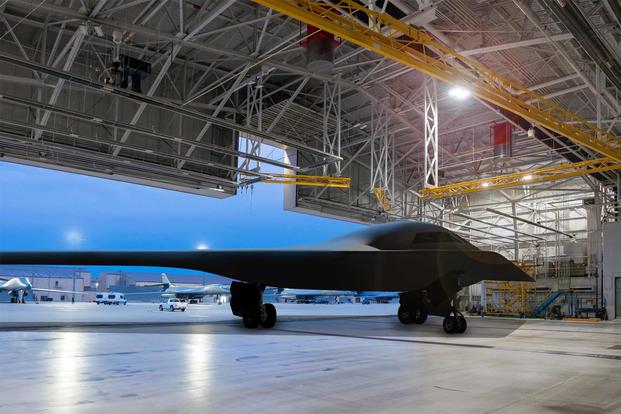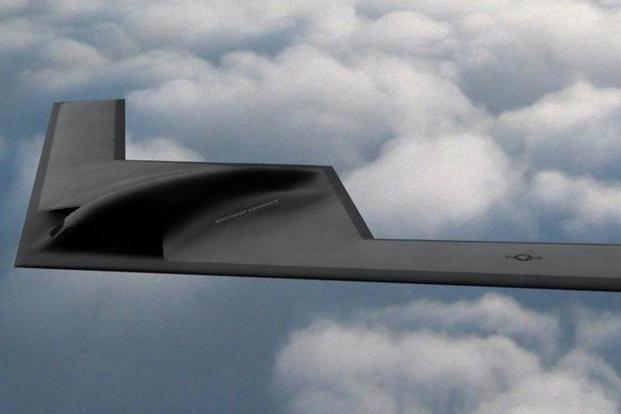The opinions expressed in this op-ed are those of the author and do not necessarily reflect the views of Military.com. If you would like to submit your own commentary, please send your article to opinions@military.com for consideration.
The Raiders are on their way. The Northrop Grumman B-21 Raider is supposed to be the US Air Force's (USAF) next great long-range bomber. If Air Force expectations pan out, a hundred or more of the bombers will join the fleet in the next decades, providing the core of one-third of the nuclear triad and a lethal precision strike capability.
What is the B-21 supposed to be capable of, and how is the project going?
The B-21 Has a Purpose: Reinvigorate the Bomber Force
Originally termed the LRS-B (Long Range Strike Bomber), the B-21 Raider is intended to replace the greater portion of the U.S. bomber fleet and to provide long-range penetration capability for the next century.
The existing USAF strategic fleet consists of an odd mishmash of three Cold War aircraft. The B-52 Stratofortress has served in the USAF since the 1950s and, under all projections, will continue to serve for the foreseeable future. The B-1B Lancer, developed in the 1970s, has given up its nuclear mission but continues to serve in a conventional capacity. B-1B airframes were used hard during the Wars on Terror. Finally, the remaining 20 B-2 Spirit stealth bombers have served since the 1990s.
While variety is the spice of any air force, the combination of the three Cold War legacy platforms leaves much to be desired. The B-52 is a magnificent airframe, but there are missions (including deep strike) that it simply cannot perform under modern conditions. The B-1B force has been relegated to conventional missions and does well enough in that role with appropriate upgrades, but the entire fleet is growing older and more expensive. The B-2s are exorbitantly expensive to keep in service, both because of their stealth characteristics and because the tiny size of the fleet drives up training, parts, and maintainer costs.
B-21 Draws from B-2 Spirit
Thus the Raider, a bat-shaped bomber that very much resembles the B-2. Northrop Grumman's tender promised a design that would integrate as many mature technologies as possible, hoping to avoid the cost overruns and component problems that have plagued nearly every other stealth aircraft in service.
In appearance, mission, and in many key components, the B-21 draws heavily upon the B-2. The Raider is smaller than the Spirit but with a similar expected (subsonic) speed and half the weapons payload. Initial plans for the B-21 allowed for unmanned mission profiles, although this obviously would never have been suitable for the nuclear mission.
The Air Force expects at least 100 Raiders and possibly an additional 100 aircraft above that level depending on need and on the progress of the project.
B-21 Progress
By all indicators, the B-21 programs seems to be proceeding remarkably, almost shockingly, smoothly. At least for now.
The Raider's first flight is projected to come in 2023. A recent Bloomberg report indicated that the B-21 is actually staying under its projected budget for the time being, an exceedingly unusual status for an advanced aircraft project. There seem to be few doubts inside or outside the Air Force that the B-21 will hit or come near enough its benchmarks.

It's hard to remember any Pentagon program, much less a highly advanced stealth bomber project, performing as well as the Raider has proceeded thus far. There is little question that Northrop Grumman's long, challenging experience with the B-2 (a project that suffered essentially every catastrophe that a big Pentagon project can endure, including a classic procurement “death spiral”) helped inform the B-21 bid and ensured that many missteps could be avoided.
It's worthwhile to remain cautious. There's too much complexity and too many things that can go wrong. Even as Northrop Grumman has tried to cut down on the number of potential issues by using mature components, the rapidly changing technological and strategic environments may force updates to the project that will create time and cost overruns.
B-21 Future Looks Bright (Well, if A Stealth Bomber Can Be ‘Bright'?)
In service, the B-21 will probably not be transformational. Unlike the B-2 or the B-52, it does not provide a revolutionary strike capability, and unlike the B-1B, it will not deliver mind-blowing visual performance. However, if successful, the project will mean that the bomber fleet of the USAF can continue to put targets under threat deep in both China and Russia.
How long will the B-21 remain in service? The B-2 is now over thirty years old, the B-1B over forty, and the B-52 a staggering seventy. The Air Force certainly hopes that the Raider will stick around for a good long time, but there are reasons for doubt. The effectiveness of a stealth aircraft depends on a particular configuration of technologies, and it is altogether possible that advances in sensors may make the low visibility characteristics of the Raider obsolete. Then again, the mission profile of the B-52 and the B-1B have changed so much over their lifespans, and it's quite likely that the Air Force will figure out how to keep the bombers useful.
Dr. Robert Farley has taught security and diplomacy courses at the Patterson School since 2005. He received his BS from the University of Oregon in 1997, and his Ph. D. from the University of Washington in 2004. Farley is also a founder and senior editor of Lawyers, Guns and Money.
This article originally appeared on 19fortyfive.com.














